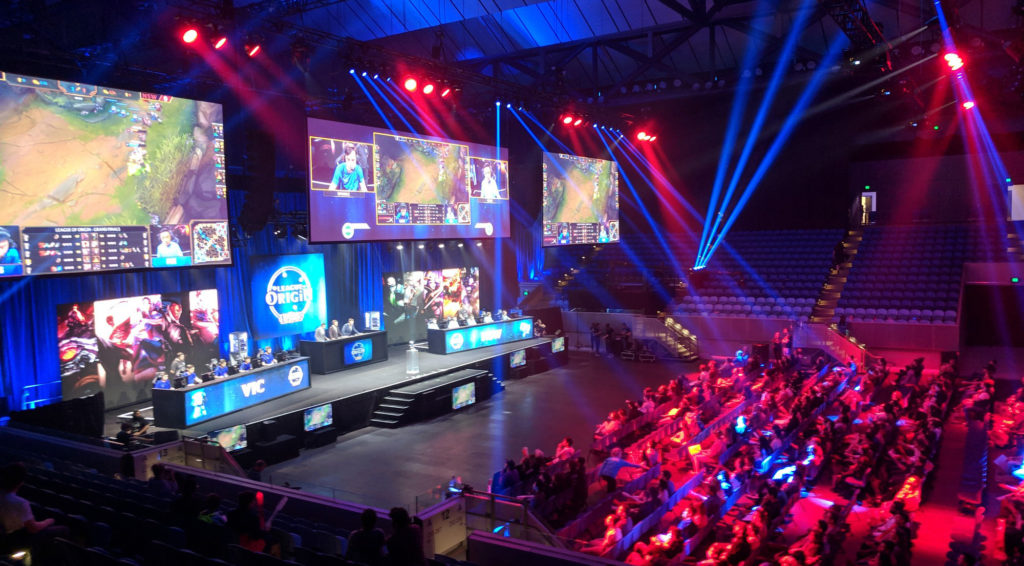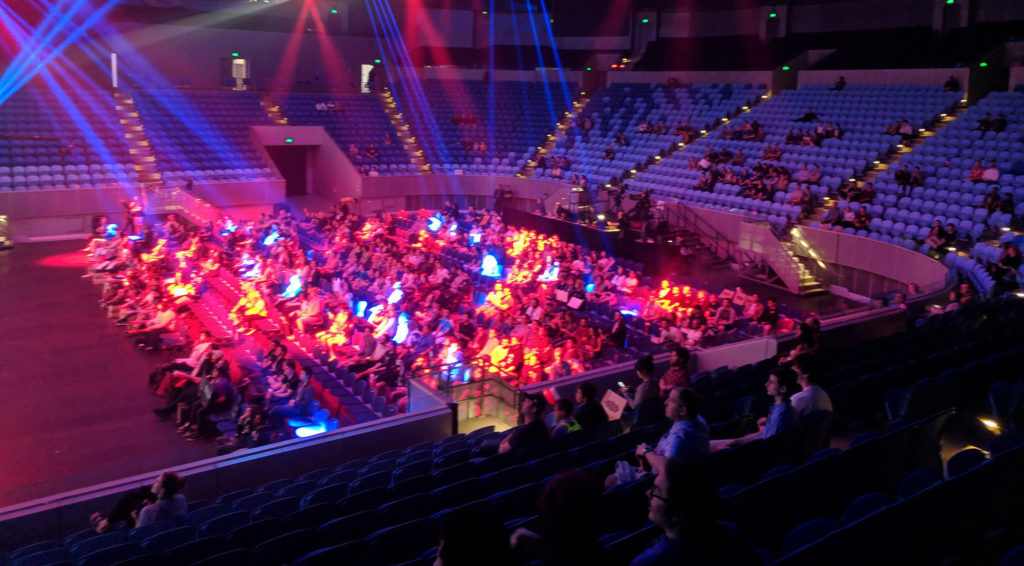On November 17 I had the opportunity to attend what was in many respects a milestone event in Australian esports – the League of Origin final, held at Margaret Court Arena at Melbourne’s famous tennis centre, and hosted jointly by Riot Games and the Australian Football League.
The partnership between the AFL and Riot had sparked much excitement around gaming and esports circles. With Australia’s biggest and best run sporting administration pushing seriously into esports via League of Legends, was this the boost the sector needs to bring true legitimacy and momentum?

In the end, the event attracted not much more than 1,000 attendees (many there on free tickets, it seemed), and limited views on Twitch (again, less than 1,000 on the official stream). Arguably, for a first attempt, it was a reasonable effort. Production values were good, no doubt the AFL learnt a lot, and Melbourne can claim another significant esports event on the journey towards mainstream.
But it is apparent that the sector in Australia faces a number of challenges. As an observer, I am generally optimistic about the long term prospects for a sustainable competitive gaming industry in Australia; there are plenty of reasons to be optimistic. But there are also some very serious challenges that are not going away.
So here I present my Reasons for Optimism and Reasons for Pessimism about esports in Australia.
I’d love to read your thoughts in the comments section, whether you agree, disagree, and/or have some ideas for how to overcome the challenges and see the stadium as half full, rather than half empty.
Reasons for optimism:
- The size of the potential market/audience. NewZoo, the commonly-cited esports and gaming research house, reports the global esports audience reached 380 million in 2018, with more than half of those in the Asia-Pacific region, and growing to 557 million by 2021 (almost 15% CAGR). It also predicts the commercial value of the market to grow at 40% a year through to 2020 and reach US$1.4 billion or more.
- The unique nature of the audience. According to Twitch, one in four Twitch viewers are completely out of reach of traditional media channels. These are customers that are not engaging with brands in traditional ways. For brands, connecting via the passion point of gaming or esports is potentially the most accessible way of building a brand and driving sales within the younger demographics.
- Major players are showing interest, and bringing capabilities and capital. The local sector needs money to grow, and it needs capabilities in things like event management, league management, integrity, fan development, and commercialisation. Major sporting brands like the AFL, and AFL Clubs Adelaide and Essendon (who each have esports divisions), and new-to-esports but long-time watcher and advisor on sports fan engagement trends Sean Callanan (aka Sports Geek) will bring skills that are not yet well developed among esports natives. Big, influential brands like Telstra and PwC bring a legitimacy just by being seen to be looking at the space, drawing others in. The Victorian Government has already invested in the Melbourne Esports Open, helping to fund it for four years. Big global brands like Red Bull lead the way for other, more conservative, brands to follow. And major media companies like HT&E and Hoyts, which are backing the Gfinity league in Australia, are leveraging their traditional media assets (out of home, radio, digital and cinema) to explore and promote esports. All this will only serve to develop the infrastructure the sector needs to be successful and sustainable.
- Forecast growth rates for esports are significantly greater than other traditional sporting territories. PwC has published data that suggest esports will grow faster than football, basketball, mass participation sports, or mixed martial arts – all major global sports with significant media and commercial momentum. Whether or not these projections come true hardly matters – merely by publishing the data it draws attention to the sector and encourages investment, which will accelerate development.
- Global opportunities for Australian players and teams to reach massive scale. Unlike AFL, NRL or even rugby union and cricket, esports is global. This creates opportunities for Australia and Australians to leverage global interest and growth to achieve scale the AFL potentially never could. Australian teenager Anathan Pham moved from Victoria to China as a 16-year-old to chase his esports dreams. Earlier this year he won a share of $15.3 million in prize money as part of OG’s winning team at the Dota 2 International Championships in Vancouver. At just 18, he is one of Australia’s highest-earning athletes in 2018.
Reasons for Pessimism:
- Australian audience numbers are minuscule compared to what’s reported globally. It is widely reported (if not well sourced) that the League of Legends World Championships in 2017 were watched by 60 million people globally. These huge numbers get people interested and excited, but the disconnect to actual streaming and attendance numbers in Australia is stark. Viewer numbers on the League of Origin final on Twitch haven’t topped 1,000 at last check. (Although the stream was also shown on Red Bull’s Facebook page, which increased reach, Facebook too has its own issues with the credibility of video streaming numbers.) Twitch and Riot and others talk a big game and cite big numbers, but these numbers tend to be aggregates and very difficult to compare to traditional sport reach metrics, making it hard for sponsors to compare and make decisions to invest. My fear is that in esports, as in other global sports such as football and basketball, Australia may always be sub-scale (see A-League v. EPL, and NBL v. NBA).
- Our talent pathways are under-developed and will take years to build. Most top esports players are young and inexperienced. Their coaches and managers (if they have them) are just as young and inexperienced. Yes, new AFL recruits are also young, but they have a well-established industry of agents, lawyers, high performance coaches, player welfare managers and others around them. Australian esports is only recently starting to build a pattern of decent player contracts, structured training and nutrition regimes, and so on. Early talent identification pathways are starting to emerge (e.g. the HSE High School ELeague), but we do not have a deep talent pool of players pushing those at the top to get better. We are a long way from having a pipeline of highly competitive players across the various esports titles to allow us to compete consistently on a regional or global level.
- The content can be hard to understand for newcomers. Sitting in the arena watching the League of Origin, as a relative newcomer to League of Legends I found it very challenging to learn and understand the game. Shoutcasters (commentators) were centre-stage at the event, providing live play-by-play calls and plenty of analysis in breaks – however, the common format in esports broadcasting is to replicate ESPN-style coverage of traditional sports, aimed at knowledgeable fans and diving deep into arcane details. For esports to broaden its appeal, the way the game is covered needs to evolve. We are yet to see consistent, well-produced and focused content aimed at new fan development. I had anticipated the AFL would have taken a more accessible approach to its coverage and production of this event in an effort to appeal to AFL fans with little knowledge of LoL, but this was evidently not the case.
- Esports is not a single territory – the multitude of game titles and formats make it difficult to build an addressable audience at scale. Of course League of Legends is just one of many top-tier esports titles, and indeed just one within the MOBA genre. The constant emergence of new games like Fortnite (arguably not an esports title) further fragment the audience. As a fan, or as a potential sponsor, where do I focus? Gfinity is one example of a league attempting to bridge this gap and aggregate fans of three different game titles (CS:GO, Rocket League and Street Fighter) around a single event and city-based teams. Multi-team brands like Cloud9 also diversify across game titles to build audience reach. But there is no single esport – it is as diverse as all of traditional sport, where of course we find sports fans that may love or hate football, rugby, cricket or basketball, but rarely are they highly passionate about every sporting format.
- No clear sustainable business model (unless you are a game publisher). Riot and Blizzard seem to be doing OK financially, with amateur gamers paying cumulative millions of dollars in in-game purchases to these publishers. Private and venture capital has flooded into the wider esports ecosystem, driving licence fees for teams to play in top leagues into the tens of millions of dollars. Yet for teams, independent leagues, and the vast majority of esports athletes, a sustainable profitable business model remains elusive. Brands are sniffing around the edges and sponsoring some entities, but it would seem that even the biggest and best-known esports brands in Australia are burning through cash at a worrying rate.
- Under-developed governance. Unlike with most traditional sports, esports has no single governing body or federation to set and enforce standards. Matters like anti-doping or match fixing are in the hands of publishers or league organisers and are likely not consistently applied globally. We see loose and inconsistent player contracts, and nowhere really that is consolidating media or commercial rights to make investing in esports more accessible for sponsors or broadcasters. While there are a number of bodies here in Australia emerging to play a role (for example, the Esports Games Association of Australia), the likelihood of a single benevolent governing body emerging seems low, with so many private interests already involved. Could the push to bring esports to the Olympic movement be the catalyst for forming more structured governance? In my view that is some way from being feasible, or even desirable, for esports or the Olympics.
The verdict
While esports has plenty of potential, there are years of hard work ahead to build a sustainable sector here in Australia. To me, Australian esports at the end of 2018 feels a bit like the Internet in 1999:
- Much excitement about the potential
- Early money and investors pouring in, despite the lack of a clear business model
- The fundamental element of a passionate audience is there, but it is highly fragmented
- A potential “bubble” right now – will it hold and continue to steadily expand, or will it deflate or even burst?
- Long term, a viable sector will emerge but it probably won’t look like it does now
- Some people will lose some skin because they went in too early, while others with the capital and commitment will push through and build the future of the sector in Australia
At Gemba, we continue to assist our sporting, entertainment and brand clients navigate the esports landscape and find opportunities in the short term, with an eye to how the industry is evolving for the future.
At League of Origin, the stadium was more than half empty. But the sense among the audience – a mix of LoL fans and interested #sportsbiz observers – remained optimistic.
